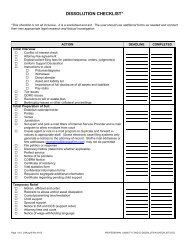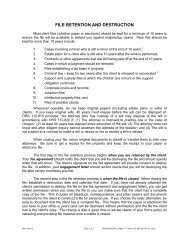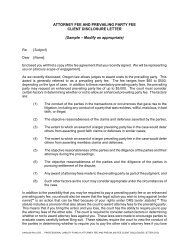ABA Model Guidelines for the Utilization of Paralegal Services
ABA Model Guidelines for the Utilization of Paralegal Services
ABA Model Guidelines for the Utilization of Paralegal Services
- No tags were found...
You also want an ePaper? Increase the reach of your titles
YUMPU automatically turns print PDFs into web optimized ePapers that Google loves.
obligations <strong>of</strong> <strong>the</strong> lawyer. Comment 1 to <strong>Model</strong> Rule 5.3 makes it clear that a lawyer must give<br />
“such assistants appropriate instruction and supervision concerning <strong>the</strong> ethical aspects <strong>of</strong> <strong>the</strong>ir<br />
employment, particularly regarding <strong>the</strong> obligation not to disclose in<strong>for</strong>mation relating to <strong>the</strong><br />
representation <strong>of</strong> <strong>the</strong> client, and should be responsible <strong>for</strong> <strong>the</strong>ir work product.” Disciplinary Rule<br />
4-101(D) under <strong>the</strong> <strong>Model</strong> Code provides that: “A lawyer shall exercise reasonable care to<br />
prevent his employees, associates and o<strong>the</strong>rs whose services are utilized by him from<br />
disclosing or using confidences or secrets <strong>of</strong> a client. . . .” Nearly all states that have guidelines<br />
<strong>for</strong> utilization <strong>of</strong> paralegals require <strong>the</strong> lawyer “to instruct legal assistants concerning client<br />
confidences and to exercise care to ensure <strong>the</strong> legal assistants comply with <strong>the</strong> Code in this<br />
regard.” See, e.g. New Hampshire Rule 35, Sub-Rule 4; Kentucky Supreme Court Rule 3.700,<br />
Sub-Rule 4; Indiana Rules <strong>of</strong> Pr<strong>of</strong>'l Responsibility, Guideline 9.10.<br />
<strong>Model</strong> Rule 5.3 fur<strong>the</strong>r extends responsibility <strong>for</strong> <strong>the</strong> pr<strong>of</strong>essional conduct <strong>of</strong> paralegals<br />
to a “partner, and a lawyer who individually or toge<strong>the</strong>r with o<strong>the</strong>r lawyers possesses<br />
comparable managerial authority in a law firm.” Lawyers with managerial authority within a law<br />
firm are required to make reasonable ef<strong>for</strong>ts to establish internal policies and procedures<br />
designed to provide reasonable assurance that paralegals in <strong>the</strong> firm act in a way compatible<br />
with <strong>the</strong> relevant rules <strong>of</strong> pr<strong>of</strong>essional conduct. <strong>Model</strong> Rule 5.3(a), Comment 2.<br />
The NFPA <strong>Model</strong> Code <strong>of</strong> Pr<strong>of</strong>essional Ethics and Responsibility and <strong>Guidelines</strong> <strong>for</strong><br />
En<strong>for</strong>cement, EC-1.5 states that a paralegal “shall preserve all confidential in<strong>for</strong>mation provided<br />
by <strong>the</strong> client or acquired from o<strong>the</strong>r sources be<strong>for</strong>e, during, and after <strong>the</strong> course <strong>of</strong> <strong>the</strong><br />
pr<strong>of</strong>essional relationship.” Fur<strong>the</strong>r, NFPA EC-1.5(a) requires a paralegal to be aware <strong>of</strong> and<br />
abide by all legal authority governing confidential in<strong>for</strong>mation in <strong>the</strong> jurisdiction in which <strong>the</strong><br />
paralegal practices and prohibits any use <strong>of</strong> confidential in<strong>for</strong>mation to <strong>the</strong> disadvantage <strong>of</strong> a<br />
client. Likewise, <strong>the</strong> NALA Code <strong>of</strong> Ethics and Pr<strong>of</strong>essional Responsibility, Canon 7 states that,<br />
“A legal assistant must protect <strong>the</strong> confidences <strong>of</strong> <strong>the</strong> client and must not violate any rule or<br />
statute now in effect or hereafter enacted controlling <strong>the</strong> doctrine <strong>of</strong> privileged communications<br />
between a client and an attorney.” Likewise, NALA <strong>Guidelines</strong> state that paralegals should<br />
“preserve <strong>the</strong> confidences and secrets <strong>of</strong> all clients; and understand <strong>the</strong> attorney’s code <strong>of</strong><br />
pr<strong>of</strong>essional responsibility and <strong>the</strong>se guidelines in order to avoid any action which would involve<br />
<strong>the</strong> attorney in a violation <strong>of</strong> that code, or give <strong>the</strong> appearance <strong>of</strong> pr<strong>of</strong>essional impropriety.”<br />
NALA Guideline 1 and Comment.<br />
Guideline 7: A lawyer should take reasonable measures to prevent conflicts <strong>of</strong><br />
interest resulting from a paralegal’s o<strong>the</strong>r employment or interests.<br />
Comment to Guideline 7<br />
Loyalty and independent judgment are essential elements in <strong>the</strong> lawyer’s relationship to<br />
a client. <strong>Model</strong> Rule 1.7, comment 1. The independent judgment <strong>of</strong> a lawyer should be<br />
exercised solely <strong>for</strong> <strong>the</strong> benefit <strong>of</strong> his client and free from all compromising influences and<br />
loyalties. EC 5.1. <strong>Model</strong> Rules 1.7 through 1.13 address a lawyer’s responsibility to prevent<br />
conflicts <strong>of</strong> interest and potential conflicts <strong>of</strong> interest. <strong>Model</strong> Rule 5.3 requires lawyers with<br />
direct supervisory authority over a paralegal and partners/lawyers with managerial authority<br />
within a law firm to make reasonable ef<strong>for</strong>ts to ensure that <strong>the</strong> conduct <strong>of</strong> <strong>the</strong> paralegals <strong>the</strong>y<br />
employ is compatible with <strong>the</strong>ir own pr<strong>of</strong>essional obligations, including <strong>the</strong> obligation to prevent<br />
conflicts <strong>of</strong> interest. There<strong>for</strong>e, paralegals should be instructed to in<strong>for</strong>m <strong>the</strong> supervising lawyer<br />
and <strong>the</strong> management <strong>of</strong> <strong>the</strong> firm <strong>of</strong> any interest that could result in a conflict <strong>of</strong> interest or even<br />
give <strong>the</strong> appearance <strong>of</strong> a conflict. The guideline intentionally speaks to “o<strong>the</strong>r employment”<br />
ra<strong>the</strong>r than only past employment because <strong>the</strong>re are instances where paralegals are employed<br />
by more than one law firm at <strong>the</strong> same time. The guideline’s reference to “o<strong>the</strong>r interests” is<br />
intended to include personal relationships as well as instances where <strong>the</strong> paralegal may have a<br />
Page 9
















